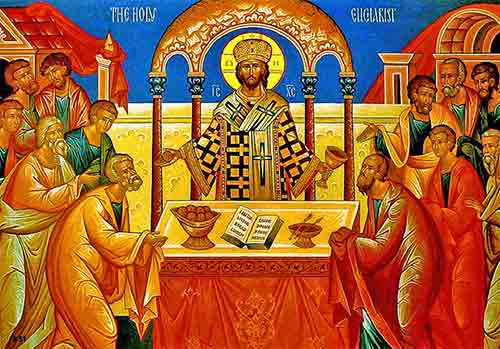
This post follows my reflection on the Eucharistic Prayer starting page 420 in A New Zealand Prayer Book He Karakia Mihinare o Aotearoa (NZPB/HKMA), a further reflection on the Eucharistic Prayer starting page 436, and the third reflection on the Eucharistic Prayer starting page 467.
In reflecting on the quality of a Eucharistic Prayer (a Great Thanksgiving), here are some of the things I’m looking out for:
- Clearly a prayer of thanksgiving – consecrating by the community giving thanks (led by the gathered community’s presider) for the great acts of God
- following the Jewish Berakah structure (Praise – Proclaim – Petition – Praise)
- Easily-remembered, consistent responses and acclamations (so preferably poetic and singable) for the gathered community so that they are not focusing on a book (or a projector screen)
- Inclusive and expansive language
- A prayer that flows well, keeps to a consistent tone, and has a broad enough theology to cover acceptable interpretations
Let’s look at another Eucharistic Prayer authorised or allowed in the Anglican Church in Aotearoa, New Zealand and Polynesia.
Thanksgiving and Praise (p.485)
Like the Eucharistic Prayer from p436 and p467 (and unlike the prayer beginning p420), this prayer is primarily the work of one person, in this case, Rev. Richard Easton, Vicar of Northland-Wilton had been experimenting with the “St Anne Liturgy” (“Northland Rite”; “Pink 3”). Having said that, it needed acceptance by the whole Prayer Book committee, and then, of course, being passed by the twice-round process to make it a formulary of our Church (General Synod – episcopal units – back to General Synod…)
Its history is clearly explained here (especially from page 58 onwards). For the 1984 communion booklet, this prayer was essentially one of two options to a significantly different rite. In A New Zealand Prayer Book He Karakia Mihinare o Aotearoa, this is the rite that is diglot – Te Reo Māori on the left, English on the right.
From my thesis p117 onwards, you can see the evolution of this prayer from essentially having the same responses, as the first two prayers we looked at have, towards how we know it today.
Sursum corda (“Lift up Your hearts…”) has been there from our earliest Christian liturgies. This also means that it is present across the different Christian denominations – Orthodox and Western. This new response, Lifting our hearts to heaven, to a place where we say Christ in glory reigns, comes across as escapism from this physical world and encouraging an unhelpful dualism. Initially, this was presented as the response for all Eucharistic Prayers at the 1987 meeting of General Synod. But that General Synod built on the concept of different responses for different rites, and for Prayers 1 and 2, reverted to the traditional, ecumenical form.
The shared Sursum corda (Lift up your hearts. We lift them to the Lord.) is restored in the revised version called, Alternative Great Thanksgiving D.
From earliest drafts, the traditional Sanctus/Benedictus is missing. Some of this can be put down to increasing sensitivity to inclusive language and the greater ease to use a completely new text than take a well-loved text and tinker with details.
Fascinating, without the Benedictus (“Blessed is he who comes in the name of the Lord…”) the prayer still continues as if there is a Benedictus there: “Blessed are you, most holy,…” The restored Sanctus/Benedictus in the revised version leads naturally into this “Blessed are you, most holy,…”
The words “Father” and “Lord” do not appear at all. Oddly, then, why is “Son” used no less than four times in this prayer?! [Reduced by one in the revised version].
Christ’s blood, in this prayer, is shed “for all” (rather than the “for many” used elsewhere). New Zealand’s eccentric “do this to remember me” is retained.
There is a deliberate handing of what is usually proclaimed by the presider to the congregation – the whole, complex anamnesis was said by the congregation in 1984. The presider starts them off on this in NZPB/HKMA, and it is given to the presider to proclaim in the revised version.
A weak understanding of a Eucharistic Prayer’s structure meant there was no doxology in the 1984 version. This is rectified in the NZPB/HKMA version.
Finally, do we think it is true that we are all, as the prayer declares, “called to suffer”?


